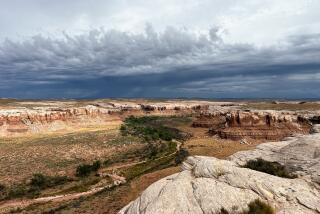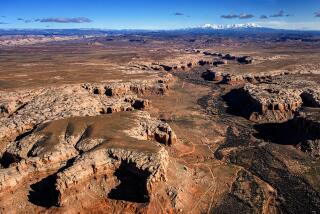Where the roads end
LAST SUMMER in Colorado, I asked my 10-year-old son, Ross, where we should hike that morning. Should we take the old road up the ridge, climbing to alpine meadows that overlook the Maroon Bells Wilderness? Or should we take “the road less traveled by,” a rutted track leading into a forest of mossy spruce?
He replied: “I have a better idea. Let’s go where there’s no road at all.”
No road at all. Such a powerful phrase! Those words evoke an endless, open, free-spirited place that exists not just on the land but in our hearts.
Despite all the land-eating sprawl, oil and gas development and population growth we see around us, the United States still has a bounty of unprotected roadless areas totaling almost 60 million acres. That amounts to one acre for every five people in this country. It is a precious gift, that open land, both for ourselves and for future generations. The great question we face today is whether we will keep it -- or squander it.
Starting almost three decades ago, the U.S. Forest Service began a process to determine the fate of those 60 million acres. Unlike the majority of our national forests, which are already open for industrial uses, these lands lacked any roads. But they also lacked any long-term protection as designated wilderness areas. They were the last of the nation’s untouched, unplanned, unzoned real estate. And the time to decide their fate had finally arrived.
What ensued was a remarkable exercise in democracy. Spanning more than 20 years, the process included official review and broad citizen participation. The Forest Service held more than 600 public meetings across the country and received a record-breaking 1.7 million official comments. This totaled five times more comments than we had ever witnessed in the development of any other federal rule. More than 95% of these comments supported the strongest possible protection of our nation’s roadless lands.
The result? The Roadless Area Conservation Rule was issued in 2001. It firmly protected the 60 million acres in question. But this amounts to only 30% of our national forests, leaving most of the rest open for timbering, extractive industries and energy development.
Enter the current Bush administration. On May 13, 2005, it announced the summary repeal of the Roadless Areas Conservation Rule. Why? The official reason was to give control to state and local authorities (even though these lands belong to all Americans). The real reason, however, was to encourage more aggressive timber sales, oil and gas drilling and mining. All those years of democratic debate, hearings and public comments went right out the window -- and into the ever-growing scrapheap of administration efforts to undermine our nation’s environmental laws and natural heritage.
The new Bush rule invites states to file petitions describing their own management plans, which opens the door to development of these areas. And if the state plans turn out to be too favorable to conservation, the Forest Service isn’t obligated to approve the petitions.
Even so, the people of this country have pushed back. More than 250,000 people have signed a citizens’ petition to restore the 2001 rules. In California, Oregon, Washington, New Mexico, Maine and Montana, a group of state leaders are legally challenging the administration’s shortsighted policy.
Outrage over the Bush reversal is steadily growing. Many people cherish their roadless places and want to protect them. Just as important, they understand something that President Bush and his allies do not: Such places belong to all of us, including generations to come, not just those who happen to live in the state where the public land is found.
Impatient to start our hike that morning, Ross tugged my arm and started off. We trekked for awhile on an old dirt road, then turned onto a winding deer trail. After a few hundred paces, we veered off the path, following the gaps between the stately spruce trees -- and following the winds of our own whimsy.
Now, recalling that moment, I feel strangely hopeful for our forests. Not because of our current leadership, mind you. But because there is, in most of us, a yearning to follow a 10-year-old into terrain where there are no roads at all. There is also a yearning to know, even if we cannot go there ourselves, that such untrammeled places still exist. And above all, there is a yearning to cherish forever the roadless realms of our hearts.
More to Read
Sign up for The Wild
We’ll help you find the best places to hike, bike and run, as well as the perfect silent spots for meditation and yoga.
You may occasionally receive promotional content from the Los Angeles Times.






